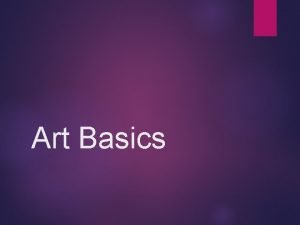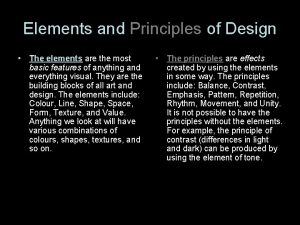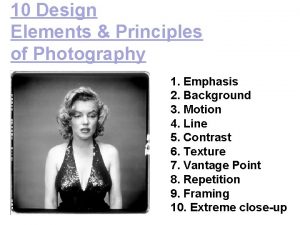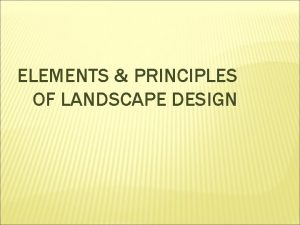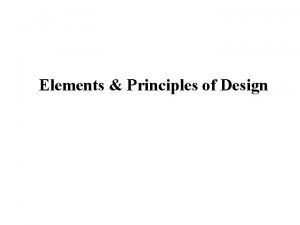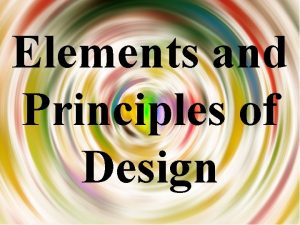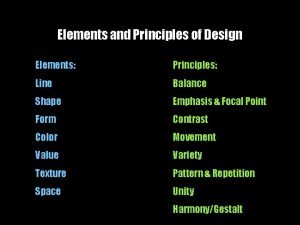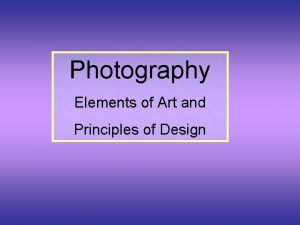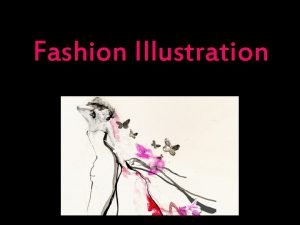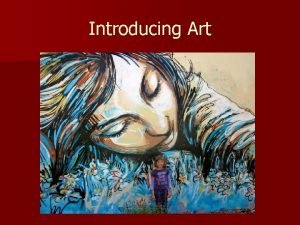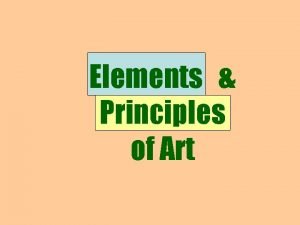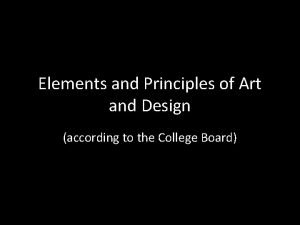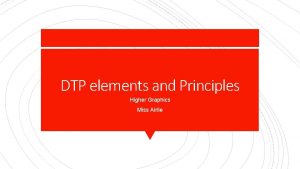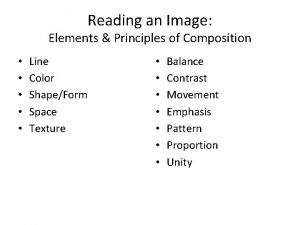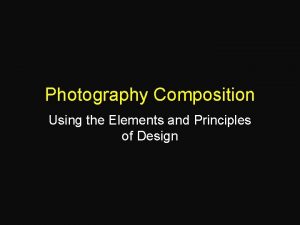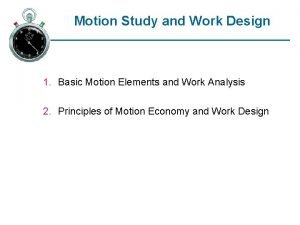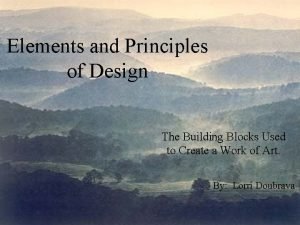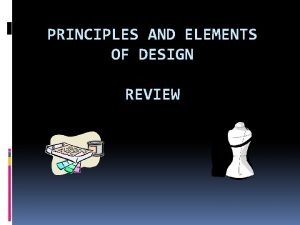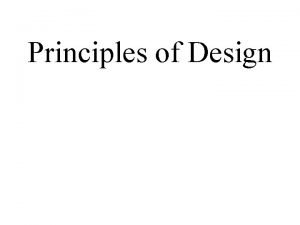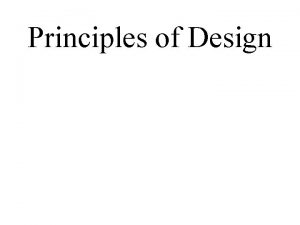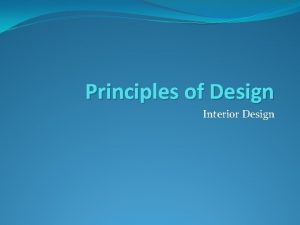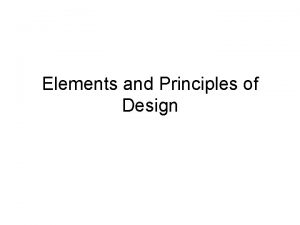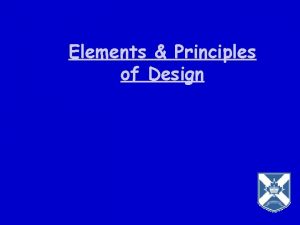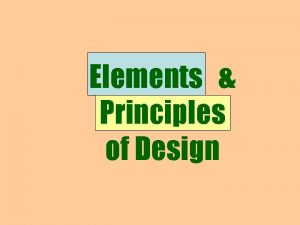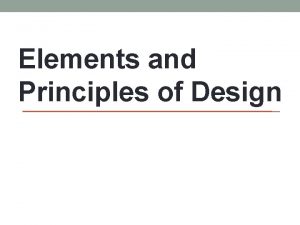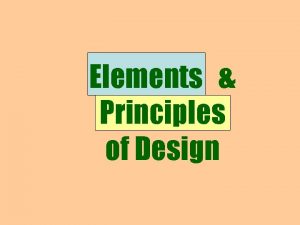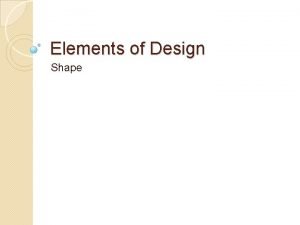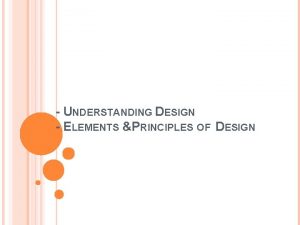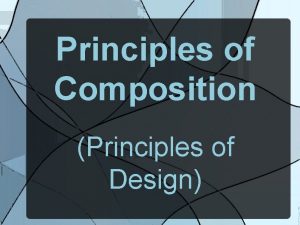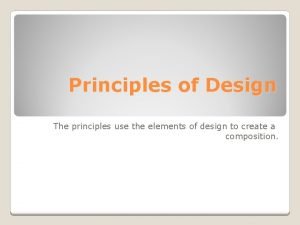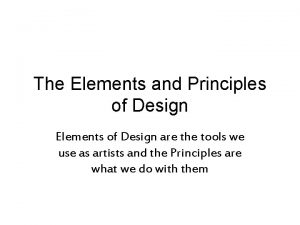Elements Principles of Design Elements of Design The



































































- Slides: 67

Elements & Principles of Design

Elements of Design *The building blocks of any artwork*

Line • is the path of a moving point.

Gesture Lines • quick, almost scribbly line drawing that captures action or movement, sometimes done in charcoal as a preliminary sketch for a painting or more finished drawing. • Draw a gesture drawing below your definition.

Hatching Lines • are a series of parallel lines varying degrees apart that can also create value. • Draw an object with hatching lines below your definition.

Crosshatching Lines • are sets of hatching lines that cross each other, and also can create value. • Draw an object using crosshatching lines.

Contour Lines • are lines that surround and define the edges of a subject, giving it shape and volume. • Draw an object using contour lines underneath your definition.

Blind Contour Lines • is a contour line drawing where you ONLY look at your subject, NOT your paper. • Take 5 minutes to draw your hands using blind contour line technique underneath your definition.

Texture • is how something feels when touched, or how it looks like it would feel if touched.

Actual Texture • is the way a surface actually feels when you touch it, such as the roughness of the bark on a tree. • Glue something from the box underneath your definition for touching. Lobi Jar with Lid 20 th century Ceramic The Minneapolis Institute of Arts

Simulated Texture • is how something looks like it would feel if touched. • Draw simulated textures underneath your definition. Juan Sanchez Cotan, Still Life with Quince, Cabbage, Melon, and Cucumber, 1600, Oil Touching a photograph.

Shape • is an enclosed 2 -dimensional area measured with height and width. There are two different types of shapes, geometric and organic. Composition VIII, 1923

Geometric Shape • is a shape with a mathematical design. They tend to be exact and are typically made with straight lines (except for circles and ovals). • Draw examples of geometric shapes underneath your definition. Piet Mondrian, (Dutch) 1872 -1944, Boogie-Woogie, 1942 -43. Oil on canvas, 50 x 50" (127 x 127 cm). The Museum of Modern Art, New York.

Organic Shape • is a shape with natural free flowing characteristics. They tend to be found in nature. • Draw examples of organic shapes underneath your definition. Joan Miro (Spanish) 18931983, The Policeman, Oil on canvas, 1925, 248 x 194. 9 cm, The Art Institute Of Chicago

Form • is an enclosed 3 -dimensional area measured with height, width, and volume. There are two types of form, geometric and organic. Michelangelo Buonoratti (Italian ) 1475 -1564, David, 1501 -1504, 15 feet, Marble, Galleria dell'Accademia, Italy Paul Herman, Portrait Sierra de Aracena, Sevilla, 1994, Oil on canvas Self

Geometric Form • is a form with a mathematical design. They tend to be exact and are typically made with straight lines (except for spheres). • Draw geometric forms underneath your definition.

Organic Form • is a form with natural free flowing characteristics. They tend to be found in nature. • Draw organic forms underneath your definition. Paul Herman, Self Portrait Sierra de Aracena, Sevilla, 1994, Oil on canvas A tree found in nature Henry Moore, Locking Piece, 1963 -64

Value • is the lightness and darkness of a color. It can also make a flat, 2 -dimensional shape have the illusion of a 3 -dimensional form. Marc Chagall, (Russian),

Value Scales Use a #2 pencil and a colored pencil to draw two 6 section value scales.

Value Blending Crosshatching Hatching Scribbling Hatching Stippling

Color • Occurs when light in different wavelengths hits our eyes. • Color Spectrum: is a row of colors created when light passes through a prism.

Color • Hue: is the color wheel name of the color such as yellow or yellow-green. • Tint: when white is added to a color to make it lighter value. • Shade: when black is added to a color to make it darker value.

Color Wheel Draw the color wheel shown below.

Color Wheel • Primary Colors: Red, Yellow, and Blue – 2 Important Things About the Primary Colors: • No mixture of colors can make the primary colors. • The primary colors can be mixed to make any color on the color wheel. • Color the primary colors onto your color wheel. They are the middle sections. Also color their tints which are the outside sections and their shades which are the inside sections. • Label the color with a P next to it. Circle the P.

Color Wheel Draw the color wheel shown below. Yellow (P) ) R (P ed Blu e (P )

Color Wheel • Secondary Colors: Orange, Green, Violet Two primary colors mixed together make a secondary color. • Color the secondary colors onto your color wheel. They are the middle sections. Also color their tints which are the outside sections and their shades which are the inside sections. • Label the color with a S next to it. Circle the S.

Color Wheel Draw the color wheel shown below. Yellow (P) Or (S) ange een r G (S) Blu ) P ( d Re Violet (S) e (P )

Color Wheel • Tertiary Colors: Yellow-Green, Blue-Violet, Red-Orange, Yellow -Orange Made by mixing a primary color and a secondary color together. Important: Always say the primary color first. • Color the tertiary colors onto your color wheel. They are the middle sections. Also color their tints which are the outside sections and their shades which are the inside sections. • Label the color with a T next to it. Circle the T.

Or (S) ange Ye (T llow ) ge an Or Yellow (P) -G re en wllo Ye ) (T Color Wheel en e r G (S) Blue-Green (T) Red. Orange (T) ) (P d e R Blu e (P) t ole i V d- Re (T) Violet (S) Blue -Viol et (T)

Color Schemes • Warm Colors: Yellow-Green, Yellow-Orange, Red-Orange, Red-Violet These colors pop out at you. They stand out. • Label the warm colors on your color wheel.

CO LO RS Or (S) ange en e r G (S) Blue-Green (T) WA RM Red. Orange (T) Ye (T llow ) ge an Or Yellow (P) -G re en wllo Ye ) (T Color Wheel ) (P d e R Blu e (P) t ole i V d- Re (T) Violet (S) Blue -Viol et (T)

Color Schemes • Cool Colors: Green, Blue-Green, Blue-Violet, Violet These colors recede into the background. Vincent Van Gogh, “Starry Night”, 1889

-G re en wllo Ye ) (T Color Wheel Ye (T llow ) ge an Or Yellow (P) Or (S) ange OR CO L CO ) (P d e R t ole i V d- Re (T) Blue-Green (T) OL WA RM Red. Orange (T) S CO LO RS en e r G (S) Violet (S) Blu e (P) Blue -Viol et (T)

Color Schemes • Monochromatic: is when only one color and it’s values are used. Christine Taylor, “Ocean Blue”, 2007, Colored Pencil on Vellum Bristol paper

Monochromatic Color Scheme • Draw a circle with six sections. • Choose a color, and write it’s name down underneath the circle. • Color in the six sections using different values of the color. • NOTE: You are only using one colored pencil. Blue

Color Schemes • Analogous: is 3 to 5 colors lined up in a row on the color wheel.

Analogous Color Scheme • Draw a circle with six sections. • Choose three to five analogous colors, and write their names down underneath the circle. • Color in the six sections using different values of each of the analogous colors. Yellow, Yellow-Green, Blue-Green

Color Schemes • Complementary colors: are two colors directly across from each other on the color wheel.

Complementary Color Scheme • Draw a circle with six sections. • Choose two complementary colors, and write their names down underneath the circle. • Color in the six sections using three different values of each of those complementary colors. Red, Green

Space • The distance or area between, around, above, below, or withings.

Position on Picture Plane (Space) • The higher up the objects are in a picture plane, the farther away they seem to be. • Draw your own example. Andrew Wyeth, (American) b. 1917, Christina's World, 1948 Tempera, 32 1/4 x 47 3/4 in. , The Museum of Modern Art, New York

Size (Space) • Objects get smaller as they move into the background. • Draw your own example. Abraham Bloemaert Shepherd Boy Pointing at Tobias and the Angel c. 1625 -1630 Oil on canvas The Minneapolis Institute of Arts

Overlapping (Space) • Draw your own example. The Antimenes Painter Black-figured Hydria c. 530 B. C. Slip-glazed earthenware The Minneapolis Institute of Arts Detail on pot

Aerial Perspective (Space) • Images in the background get hazier, cooler, lighter, and duller in color. T. Worthington Whittredge (American), 18201910)

Linear Perspective (Space) • “Linear Perspective is a term used to describe the fact that lines which are parallel in nature seem to converge (come together) in the distance. This diagram illustrates 1 -point and 2 -point perspective, where lines converge on the horizon at a vanishing point. ” Camille Pissarro Place du Théâtre Français, Paris: Rain 1898 Oil on canvas The Minneapolis Institute of Arts


Let’s draw an example: Represents 3 -dimensional space on a 2 -dimensional surface




Orthogonals: diagonal lines




Positive & Negative Space • Positive Space: is the actual image(s) in a composition. • Negative Space: The background areas around the image(s). Draw an example and label the positive and negative space. Positive Space Negative Space by Sarah Clare

Emphasis • is used to make certain parts of artwork stand out and grab the viewer’s attention. Also known as a “focal point”. • Draw your own example. http: //www. bluemoonwebdesign. com/art-lessons-4. asp

Contrast • is differences in values, colors, textures, and other elements. • If there is no contrast in an artwork, it is thought to be monotonous, uninteresting, and boring. • Contrasting values and textures • Contrasting values B. J. D. Pilling Philly Hall, “Whangarei Sky Wave”, Painting and Fibre Art • Draw your own example.

Movement • is the suggestion or illusion of motion in a painting, sculpture, or design. Your eyes are led around the composition, often to a • Draw your own example. focal point. Vincent Van Gogh Starry Night, 1889 http: //www. pblunit 10. com/mager/Van%20 Gogh. htm

Rhythm • movement created by the repetition of elements in a composition. • Draw your own example. Artist Unknown Photograph of a picket fence

Pattern • is the repetition of elements throughout a composition. • Draw your own example.

Unity • is using the elements to create a feeling that everything in the work of art works together and looks like it fits. Unity using Space • Draw your own example. http: //www. bluemoonwebdesign. com/art-lessons-9. asp

Balance • describes how artists create visual weight. http: //www. artsconnected. org/toolkit/encyc_balancesymmetry. html

Symmetrical Balance • is when one side is a mirror image of the other. • Draw your own example. Jhon Goes In Center Warrior's Cross 1991 German silver The Minneapolis Institute of Arts http: //www. artsconnected. org/toolkit/encyc_balancesymmetry. html

Asymmetrical Balance • is when elements are not the same on each side of the axis, but the visual weight is still balanced in the composition. James Whistler, American, “Arrangement in Grey and Black No. 1: Portrait of the Artist's Mother”, 1871, oil on canvas, • Draw your own example. http: //makingamark. blogspot. com/2008_01_01_archive. html

Radial Balance • is when all the elements radiate out from a central point. Rose window of the Cathedral of Notre Dame, Paris, Interior view • Draw your own example. http: //makingamark. blogspot. com/2008_01_01_archive. html

References • • http: //www. conceptart. org/forums/showthread. php? t=62688 http: //www. albertc. on. ca/library/courses/art/Elements%20 of%20 Art%20%20 ALL%20 GRADES/elements_of_art-%20 line. htm http: //wwwisg. cs. unimagdeburg. de/graphik/pub/files/Schlechtweg_1996_RLD/ http: //newberryworkshop. com/Tutorial/egg. html http: //www. homeschoolarts. com/pncl-l 1 -4. htm http: //ycdinsiders. digitalchainsaw. com/Insiders. Artist. Loft/crosshatch. htm http: //artlex. com/ • http: //www. classinfoonline. org/art 111_drawing. Terms. html • http: //www. hitrecord. org/forum/viewtopic. php? t=3832&start=15&sid= d 83343 aa 7304 b 78978187645047098 d 6 • • http: //blog. miragestudio 7. com/2006/04/creating-seamless-textures/ http: //www. freefoto. com/preview/33 -15 -15? ffid=33 -15 -15 http: //blog. phamansinh. com/category/entertainment/ http: //www. electricscotland. com/art/rightside 2. htm

References • • http: //www. picable. com/Art/Tattoo/Positivenegative-Space-Drawing. 496163 http: //www. hermanstudios. com/blog. html http: //media. photobucket. com/image/drawing%20 spheres/sashapetrenko/spherereflect-and-specular. jpg http: //www. homeschoolarts. com/pncl-l 1 -4. htm http: //www. superstock. co. uk/stock-photos-images/475 -1811 http: //fineartamerica. com/featured/ruby-glow-pattern-amy-vangsgard. html http: //www. 1902 encyclopedia. com/M/MUR/mural-decoration-15. html
 Element in hair
Element in hair List the five elements of hair design
List the five elements of hair design Balanced floral arrangement
Balanced floral arrangement Principles of design
Principles of design Elements and principles of design ppt
Elements and principles of design ppt Visual design principles and elements matrix
Visual design principles and elements matrix Line shape form color texture space
Line shape form color texture space Ci element
Ci element Steve magada trio
Steve magada trio Emphasis in photography
Emphasis in photography Rhythm stone
Rhythm stone Elements and principles of landscape design
Elements and principles of landscape design What are the elements and principles of design
What are the elements and principles of design Christina's world
Christina's world Visual elements and principles of design
Visual elements and principles of design Photography elements and principles
Photography elements and principles Elements and principles of design fashion
Elements and principles of design fashion Hình ảnh bộ gõ cơ thể búng tay
Hình ảnh bộ gõ cơ thể búng tay Frameset trong html5
Frameset trong html5 Bổ thể
Bổ thể Tỉ lệ cơ thể trẻ em
Tỉ lệ cơ thể trẻ em Gấu đi như thế nào
Gấu đi như thế nào Glasgow thang điểm
Glasgow thang điểm Hát lên người ơi
Hát lên người ơi Các môn thể thao bắt đầu bằng tiếng bóng
Các môn thể thao bắt đầu bằng tiếng bóng Thế nào là hệ số cao nhất
Thế nào là hệ số cao nhất Các châu lục và đại dương trên thế giới
Các châu lục và đại dương trên thế giới Công của trọng lực
Công của trọng lực Trời xanh đây là của chúng ta thể thơ
Trời xanh đây là của chúng ta thể thơ Mật thư anh em như thể tay chân
Mật thư anh em như thể tay chân 101012 bằng
101012 bằng độ dài liên kết
độ dài liên kết Các châu lục và đại dương trên thế giới
Các châu lục và đại dương trên thế giới Thơ thất ngôn tứ tuyệt đường luật
Thơ thất ngôn tứ tuyệt đường luật Quá trình desamine hóa có thể tạo ra
Quá trình desamine hóa có thể tạo ra Một số thể thơ truyền thống
Một số thể thơ truyền thống Cái miệng nó xinh thế chỉ nói điều hay thôi
Cái miệng nó xinh thế chỉ nói điều hay thôi Vẽ hình chiếu vuông góc của vật thể sau
Vẽ hình chiếu vuông góc của vật thể sau Nguyên nhân của sự mỏi cơ sinh 8
Nguyên nhân của sự mỏi cơ sinh 8 đặc điểm cơ thể của người tối cổ
đặc điểm cơ thể của người tối cổ Thế nào là giọng cùng tên?
Thế nào là giọng cùng tên? Vẽ hình chiếu đứng bằng cạnh của vật thể
Vẽ hình chiếu đứng bằng cạnh của vật thể Fecboak
Fecboak Thẻ vin
Thẻ vin đại từ thay thế
đại từ thay thế điện thế nghỉ
điện thế nghỉ Tư thế ngồi viết
Tư thế ngồi viết Diễn thế sinh thái là
Diễn thế sinh thái là Dạng đột biến một nhiễm là
Dạng đột biến một nhiễm là Các số nguyên tố là gì
Các số nguyên tố là gì Tư thế ngồi viết
Tư thế ngồi viết Lời thề hippocrates
Lời thề hippocrates Thiếu nhi thế giới liên hoan
Thiếu nhi thế giới liên hoan ưu thế lai là gì
ưu thế lai là gì Sự nuôi và dạy con của hươu
Sự nuôi và dạy con của hươu Khi nào hổ mẹ dạy hổ con săn mồi
Khi nào hổ mẹ dạy hổ con săn mồi Sơ đồ cơ thể người
Sơ đồ cơ thể người Từ ngữ thể hiện lòng nhân hậu
Từ ngữ thể hiện lòng nhân hậu Thế nào là mạng điện lắp đặt kiểu nổi
Thế nào là mạng điện lắp đặt kiểu nổi Types of emphasis in art
Types of emphasis in art Elements principles of art
Elements principles of art Principles of art
Principles of art Dtp elements and principles
Dtp elements and principles Elements and principles of composition
Elements and principles of composition Principles of composition in photography
Principles of composition in photography Motion economy
Motion economy Elements and principles of hybridity
Elements and principles of hybridity Elements and principles of art
Elements and principles of art






